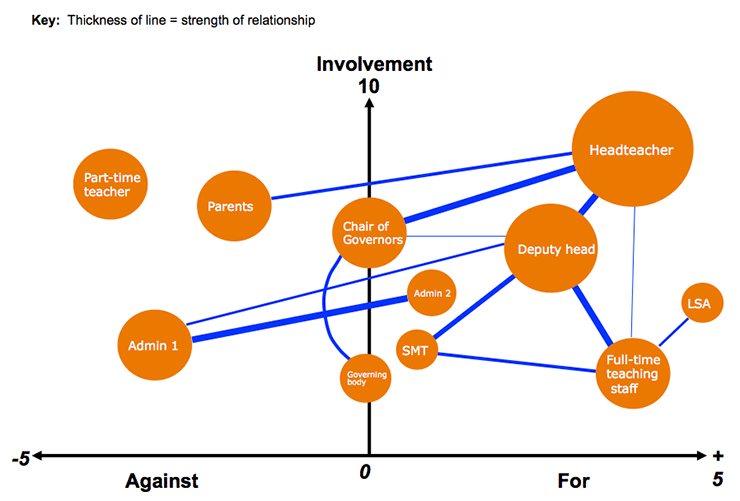Stakeholder Mapping is a graphical illustration of how your stakeholders feel towards your change project or program. It helps you to identify who you need to influence and what action you need to take.
It's one of the most powerful change management activities on WorkshopBank and a must-do activity for any project manager.
Objective
- To identify the scale and scope of issues and problem areas in any change process.
When Would You Use It?
- Early in your project. Identify the key stakeholder groups early and map their dispositions at the outset.
- Revisit in later stages as you evaluate efforts to improve positive attitudes and engage stakeholders.
Are there any rules?
- Never print or leave your map lying about – there are legal ramifications for maintaining information about individuals.
- Also, be aware that the data in your stakeholder map represents your perceptions about other people – and they may not necessarily agree with you! So it is wise to keep this sensitive information very confidential.
What is a “Stakeholder”?
- Typically you can think of stakeholders as: ‘Anyone who has a stake in the change initiative’ although this can be a bit broad.
- A more workable definition might be: ‘Anyone who can make, or break, your change project’.
- This group of more specific stakeholders can be segmented into four major groups – Sponsors, Change Teams, Reference Groups and Users.
What are the different types of “Stakeholders”?
- Sponsors (or project owners) are often those who initiate change by mobilizing the resources needed and charging people with the responsibility for getting it done. Sponsors own the requirement for change – and if the requirement changes they must direct the change project accordingly.
- Change Teams are those charged with the responsibility for executing the change and ensuring it happens. The change team is responsible for coming up with the solution to the change requirement.
- Reference Groups include those people that change teams must refer to in order to arrive at the right solution. They ensure that the change will work.
- Users are a broad group of people who benefit from the change solution. (Note: The Reference Group and some of the Change Team may also be classed as Users. This is often a good idea).

The types of stakeholders you might have
Process
- Draw the stakeholder map with two axes:
- The X axis represents the spectrum of dispositions toward your change project; from Against at one extreme – to For at the other.
- The Y axis represents the spectrum of involvement from high at the top to none at the bottom.

Note: the Y axis intercepts at the mid-point of the X axis. This represents a position on the X axis equivalent to a neutral disposition – neither for, nor against, the change.
- The group discusses each stakeholder in turn determining their location on the map by rating their relative disposition towards your project and the degree to which they are actively involved in it (use the Example Dispositions slide to help you decide where each should sit).

Note: Two stakeholders may both be actively involved, but have quite opposing dispositions towards your project: one actively undermining it while the other is actively promoting it.
- This worked example illustrates some typical stakeholder disposition towards a school change initiative. Ideally you would want everyone to be at the top right-hand corner – actively involved and championing your project! But this example shows a broad landscape of diverging dispositions that is more typical.

Note: In addition to the disposition of each stakeholder we have added one further dimension: the degree to which each stakeholder can influence the change is reflected in the size of the circle used to denote that stakeholder. This dimension reflects one aspect of the underlying political situation.
- The last step in the mapping exercise is to add a final dimension: this is the relationships that exist between stakeholders.

- In the effort to shift dispositions to a more favorable situation you might want to exploit the relationship that exists, say, between a strong supporter of your project and someone else who remains skeptical or even cynical.
Secret Sauce
- It is wise to know how each of the broad groups of stakeholders is disposed towards your change project, e.g. are they actively supportive, or unsure, skeptical or even against the change? Stakeholder mapping illustrates these dispositions – so that you can determine what action you need to take in order to shift unfavorable dispositions more positively.
- The size of the circle is important dimension to the success of change. You want the most influential stakeholders on the right of your map and migrating to the top so if they’re not you need to work out a way to get them there.
- Note that relationship can be negative as well as positive. The assumption can be that all relationships are positive ones. If you think it is relevant, you might want to illustrate a negative relationship by a broken line.
- Be careful, because stakeholder maps can contain the identities of individuals. There are legal ramifications for maintaining information about individuals.

